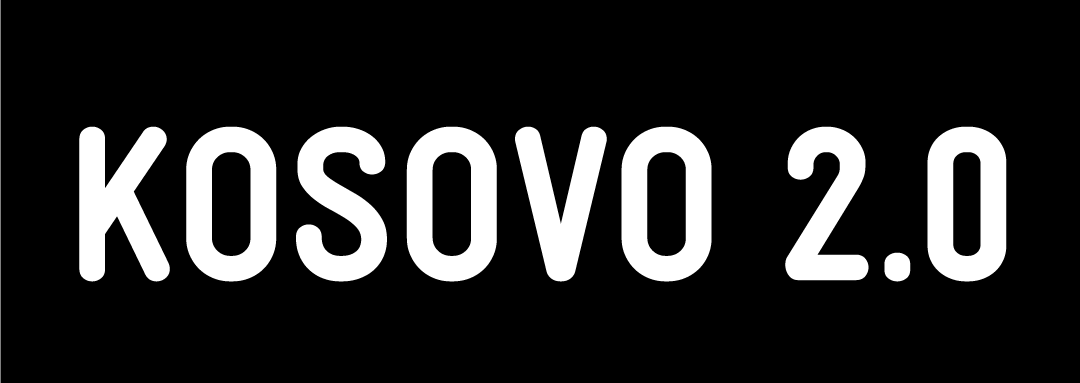Is Tirana's rapid transformation
progress or erasure?
Under the slogan "No time to rest,"
Tirana residents are losing their city.

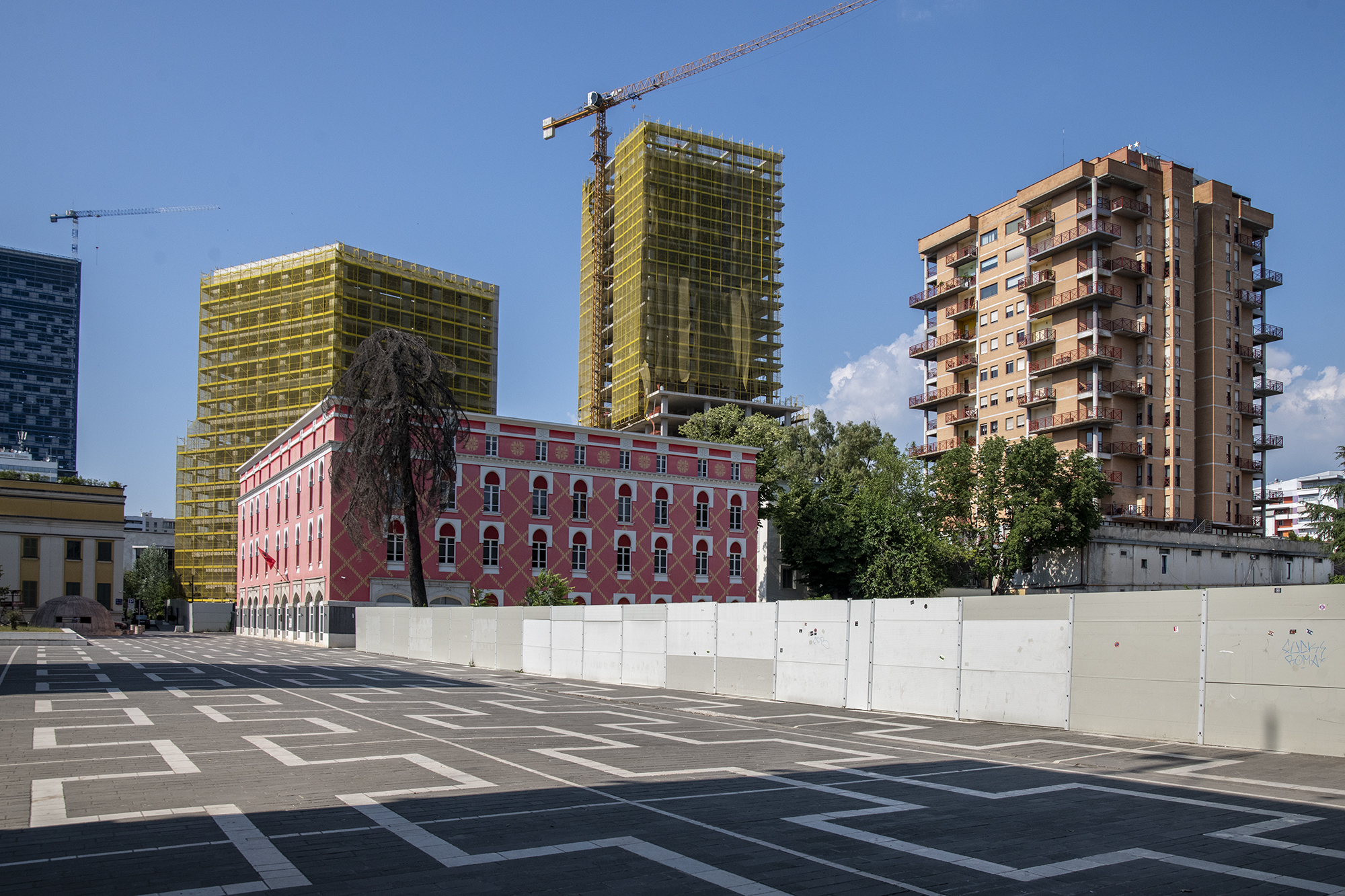
On May 17, 2020, Albanian officials violently demolished the buildings of the National Theater and the Experimental Theater following a two year effort to protect them led by Tirana locals and drawing on the support of people and activists inside and outside of Albania.
I followed the demolition live on the Facebook page of the “Alliance for the Protection of the Theater” and watched as hundreds of police officers violently entered the premises and dragged out activists. It was 11:30 p.m. where I was in Brooklyn, while in Tirana it was 4:30 a.m. and the pandemic curfew was still in effect.
I will never forget the screams of activists as those who came to demolish the theater, faces covered to obscure their identity, raised their guns to force people out of the building. Among the activists were some of my friends with whom I was in constant communication.
Unlike them, I was not in any physical danger. But being merely a spectator, unable to do anything, was frustrating. All I could do was comment on the live stream “Hey, we are watching you! The whole world can see what you’re doing!”
Was the world really watching, or was it just an illusion?
The theater buildings had significant importance for the city. Constructed between 1938 and 1939, they were witness to key moments in Albanian political and cultural history during different eras. After being left in disrepair for almost three decades and periodic attempts at demolition, in 2018, the theater was finally closed. This was when the real threat of demolition became clear.
The National and Experimental Theater
The theater buildings were originally conceived as the Albanian-Italian cultural center “Skanderbeg,” with the main hall intended for cinema. They later had different functions, serving as the place where the Albanian Writers and Artists Union was created, and where the infamous trials of 1945 happened, where figures who opposed the totalitarian regime of Enver Hoxha were sentenced to death or life imprisonment. The buildings were then adapted for the People’s Theater. After the fall of the regime, the institution was re-named the National Theater.
The buildings’ designs, created by architect Giulio Berte, were described by others as futuristic and with surrealist nods that evokes the paintings of De Chirico. Unlike other facilities during the time, the theater was light and inviting. The construction technique was innovative and one of the few such buildings outside of Italy. Throughout the years, the buildings had undergone interventions by Albanian architects and engineers, who adapted the halls for theater performances.
This was also when the theater took on its final emancipatory function, mobilizing people inside and outside Albania, among them artists, intellectuals and professionals from many fields. Activists organized a number of cultural activities to revive the theater, inside and outside the building, to show that it has potential for creative use and should be protected.
This conservation movement created an unprecedented upswell of citizens’ engagement in decision-making about the city. A wide range of professionals spoke out against the demolition. Expressions of support arrived from Docomomo, an international organization for the documentation and preservation of modernist buildings, as well as from EuropaNostra, a pan-European network for cultural heritage. The European commissioner for innovation, research, culture and education, Mariya Gabriel, called for the government and pro-demolition forces to negotiate with the activists who were fighting to protect the theater.
Whether or not any negotiations happened backstage, the voices of those who fought to save the building were not considered in the end.
The theater’s last performance was at dawn on May 17, 2020. Any hope residents had that the city belonged to them, as individuals and as a collective, was violently shattered. These events were the beginning of a power play to establish absolute control over Tirana, which were then followed by similar interventions in the center and periphery of the city.
Behind the political facade
Pressure from authorities to control and influence the cityscape is nothing new in Tirana. Both before and after 1990, those in power have transformed the city to reflect their various ideologies.
The well-known Albanian architect, Petraq Kolevica, mentions this in his 2004 book “Architecture and Dictatorship.” Kolevica attests to the pressure exerted on him as an intellectual during totalitarianism, a period when architects were stripped of intellectual individuality and forced to function in line with the one-party state.
The writer and publicist Ardian Vehbiu in his 2003 essay “Clock Tower” writes about another aspect of how the city has been transformed by top-down decision-making. Vehbiu elaborates on the tension of being both a city, inhabited by residents, and a capital at the same time. Residents’ practice of creating communal urban space has constantly fallen into conflict with officials’ desires to give it the character of a planned capital city.
When the Hoxhaist regime fell, Tirana experienced the anarchy of the “political transition,” which saw a collective outburst as a response to the end of totalitarian control. This was defined by urban construction initiated by residents themselves.
They made small additions inside Tirana’s urban structure and created entire peri-urban areas — areas near the city, which are neither rural or urban — populated and built by people displaced from other parts of the country due to lack of infrastructure, employment, education and medical facilities. What happened in Tirana’s urban peripheries was seen as an anomaly, as backwards, while inside the city there was a tendency to recognize the city’s human dimension.
In the early 2000s, tired of the lawless construction and in the name of establishing urban order, Edi Rama, then the mayor, trumpeted his success in demolishing kiosks alongside the Lana River. Similarly the 2003 joint project between Rama and artist Anri Sala, “Dammi i Colori” (Give me the colors), which involved painting gray Communist apartment blocks in vibrant colors, was a somewhat more sophisticated way to control the city.
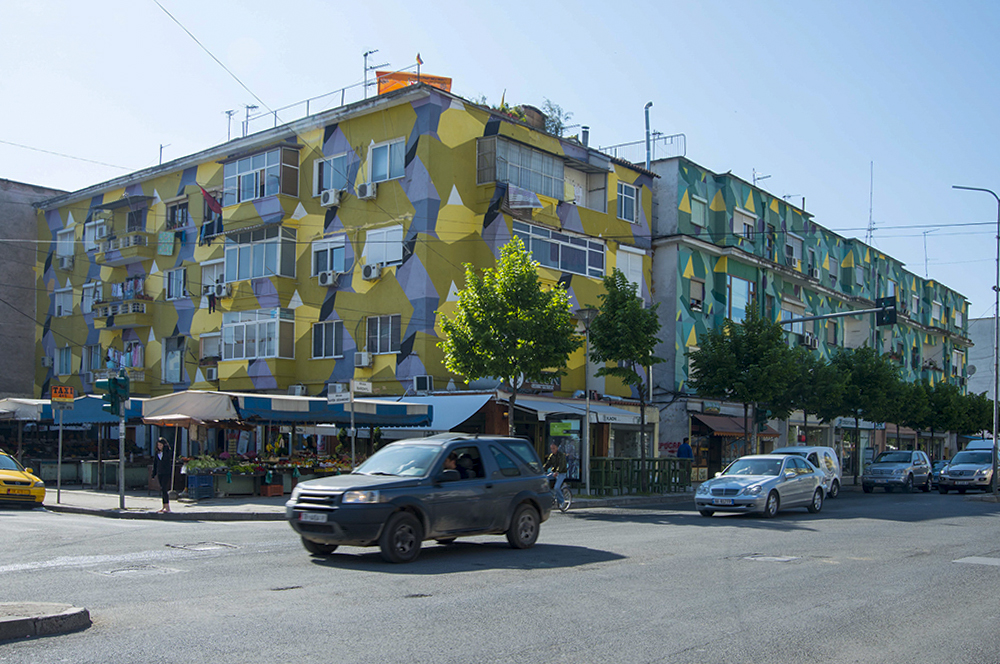
The project used the aesthetics of the everyday, of colors, of drying clothes hanging on the balcony, as inspiration for the facade paintings. Colors that embody the chaotic spirit of Tirana were placed in the foreground, on the main facades, through which the previous undemocratic powers had transmitted their ideology of order, discipline, monotony and imposed equality. These gloomy facades represented an oppressive past. The new colorful motifs suggested the liberation of the city and the promise of a new democratic era.
This was an unconventional approach for those in power, who marketed the project as a sign of empathy towards the practices of everyday life in the city. These interventions were designed to sell an expression of love, acceptance and appreciation of these practices.
Meanwhile, the excitement for this new approach was evident, especially outside Albania and legal construction projects began within the neighborhoods, with permission granted by the artist-mayor Rama. Urban planner Sotir Dhamo in the early 2000s described these interventions as urbicide — violence against the city — to highlight the destructive effect on Tirana’s urban fabric.
This politicized intervention on Tirana’s urban landscape was nothing new. Tirana developed organically until it was declared the capital of Albania in 1920. The first known attempt at planning the city can be traced back to the Austrian plan of 1917, a map of Tirana which documented the city in detail on paper for the first time.
In 1925, Italian architects, commissioned by Ahmet Zogu, proposed the first urban plan for Tirana which was then implemented during the years of the monarchy and the Italian occupation. During this period the center transformed, and saw the construction of the cosmic boulevard and administrative and cultural buildings. The Royal Palace, later renamed as the Palace of Brigades, was built at this time, as well as a number of Italian villas that together were referred to as “Tirana garden city.”

Drastic changes to the city continued throughout the Hoxha era, including the demolition of the old Ottoman Bazaar to build the Palace of Culture. The construction along the main streets of four and five-story residential buildings, built to accommodate the new socialist man, created the city’s new urban walls. Today it is common to encounter areas of the city where the road is lined with socialist-era residential buildings, behind which lie the houses of old Tirana.
The urbicide of the 2000s destroyed much of what was left of 1920s Tirana. The new construction legitimized a way of development in the city which centered private property. New buildings often took unusual forms, as a result of irregular plot shapes, themselves often a reflection of conflicts between families or neighbors, or abuses of property rights.
Conflict over property eroded the city’s social structure. What once was family or communal property fragmented into private property. This transformation was considered an inevitable part of the transition to the free market, but was in fact insensitivity towards residents from the city administration.
The last urban plan inherited from the communist era was from 1989 and it continued to be used for years as the reference document for granting building permits. However, it was interpreted, and violated, freely. People viewed it as failing to meet the needs of the new era the city has entered. The apartment building boom in Tirana was a model for other cities in Albania, particularly in coastal areas where disturbing amounts of concrete have been poured.
In 2013, the Socialist Party (SP) took power with a vision for “Renaissance” under the reformed leadership of Edi Rama, who became the head of government after his role as Tirana’s mayor. These socialists in name only regained control of Tirana municipality in 2015. Five years ago, under the leadership of Erion Veliaj, the Tirana 2030 plan was approved. The plan was designed by the renowned Milanese architect Stefano Boeri and the Rotterdam-based UNLab studio.
Bringing in renowned architects is a tactic used to captivate the Albanian public, who have grown up with an inferiority complex in relation to western foreigners who we’ve always been told know better than us. Outside experts are presented as necessary to solve “the mess we have created.” But the result is the avoidance of genuine local debate about the development of Tirana.
The meetings leading up to the Tirana 2030 plan were supposed to be public but they ended up being presentations for select groups of professionals rather than open discussions with residents about the future of their city. The public found that the decisions were made without considering their opinions or interests. But they were assured that with the approval of the regulatory plan Tirana would be taking a big step forward. The vision presented in the halls of the elite was then turned into a technical plan in which most areas of the center were zoned for high density, paving the way for new construction.
Urban compactness is a well-known concept in the field of urban planning and it is desirable in cases where there is a need to mitigate the effect of urbanization on the environment. This urban density is supposed to reduce the distances residents need to travel in their daily life. Proper implementation of a compact plan requires well-functioning technical solutions for the circulation of people and goods.
Traffic jams are one of the expected but unwanted effects of increased population numbers that urban planners try to manage. The importance of urban compactness and the negative consequences of not taking it into account in urban planning arose from observing the phenomenon of urban sprawl in cities in places like the United States, where car-based urban designs have created adverse effects on the environment and energy usage.
Tirana is different though due to its high population density. With a brief walk in the streets you see the city has many pedestrians and constant car traffic. But the Tirana 2030 plan refuses to take into account the context of the areas it plans to increase the density of, and ignores how these neighborhoods have developed so far and the communities that live there.
This plan has also been presented as championing urban greening through the planting of an orbital forest, which is supposed to function as a city boundary that will block further expansion.
The creator of the plan, Stefano Boeri, created his brand from his most famous project, the vertical forest. This is a concept that uses the vertical elevation of residential buildings and creates a facade that can be planted with trees and shrubs. The goal is to create a compact and high-density city that maintains a connection with “nature” that is often lost with the development of tall buildings.
Despite the appealing rhetoric, such architecture tends to greenwash the trend of concrete construction and social disintegration that affects communities. Further, living in such designs is only economically feasible for a small number of people because as more complex technologies are introduced, construction costs increase as well. Moreover, it individualizes one’s relationship with greenery, since it assumes that everyone will have access to it on their balcony, at the expense of a horizontal recreational space in the city where people can also socialize.
The Tirana 2030 plan and its general architectural model propose a radical transformation of the city by building upwards and calls for the unbridled building of more high-rise structures. Opening the gates to further high-rises, the plan gives a final blow to Tirana’s organic city-scape and to those few old neighborhoods with low-rise buildings that were thought to be endangered due to the lack of a plan. The plan was supposed to solve the question of the future of houses with courtyards and narrow alleys, or that of the old villas (some of which were listed as cultural monuments), many of which were demolished in the last two years and replaced by apartment buildings.
After three decades of waiting, the plan came to Tirana, but it came as a missed opportunity to recognize and appreciate the city's character.
Tirana 2030 and its supporting plans are also undermining communities in the peripheries, such as in Kombinat, a neighborhood with a unique character near the former Stalin Textile Factory. In the name of reconstruction after the November 2019 earthquake, the city is destroying collective housing under the pretext that it was damaged. With the destruction of collective housing comes also the destruction of the communities of long-time residents, who weren’t involved in the decision-making process.
Tirana 2030 also calls for destructive interventions in peri-urban areas that were built during and after the 1990s, such as the neighborhoods known as 5 Maji, Paskuqani and Lapraka. No existing form of urban set-up in Tirana can escape these interventions, which demand one model of urban development: high-rise buildings, apartment living and individuality.
After three decades of waiting, the plan was a missed opportunity to recognize and appreciate Tirana’s urban character. Unfortunately, it paved the way for a rapid transformation that will turn Tirana into a generic city with metropolitan ambitions, but without sustainable solutions to the problems that will be created by this rapid transformation. It was the pressure to make a quick profit and the greed to devour land in the city center, which some explain as due to money laundering, that is driving the rapid transformation of Tirana and that destroyed the theater, a much needed space that no longer exists.
The slogan “no time to rest,” which featured in the Socialist Party’s campaigns for the April 2021 elections and seemingly helped secure their victory, is continuously repeated in meetings and on social media. It implies there is a need to rush, but it’s not clear where the need comes from.
Similar to the pop-art tactic of painting facades, the large mural advertising of large companies and the increasing presence of massive LED screens on buildings and at street intersections, Tirana is more and more reflecting a particular ideology: commercialism. It is “The Society of the Spectacle,” but a stale spectacle that tries to dazzle us with lights and popular or psychedelic music in the central squares, while concrete trucks continue to create a new Tirana, erasing everything that stands in the way.
‘No time to rest’
I return to Tirana once again after several years outside Albania. Almost every day, at the door of the apartment where I live in the Selvia neighborhood, I find flyers with tempting offers to rent out or sell the apartment where I live. This area of town takes its name from a cypress tree that continues to stand upright and elegant; it once served as an orientation point in the city, the tallest object in the area. Although the neighborhood’s name has stood the test of time, the cypress tree itself has been lost in the concrete jungle that surrounds it.
Flyers at the door, placed by real estate agents, are not aimed at people like me who rent. It is to tempt owners in the area, where there may still be old Tirana residents who came during the years of Enver Hoxha’s rule. The overflowing flyers start inside the elevator. Not many years ago, when I lived in Tirana, the announcements were mostly about offering apartments out to renters, but today I notice a reversal, most flyers are looking for apartments to rent.
On a spring day this year, I decided to take the stairs to the top floors, where the women of the building have planted various flowers — cacti, creepers, carnations and marigolds. I find one of the flyers on the door, very simple in appearance, but with a clear message. The message reads: “I AM LOOKING FOR AN APARTMENT, to RENT out to FOREIGNERS or for PURCHASING from ‘SERIOUS CUSTOMERS.'”
Key words are marked in capital letters, highlighted and underlined. The flyer continues, assuring the reader of the professionalism, accuracy and the speed of the service, referring to the agency’s 11 years of experience. It further clarifies that the business is licensed, to quickly squash any speculation about the legitimacy of this agency. In small letters at the end, they show sensitivity to the environment; the text requests that the flyer not be thrown out as litter.
What makes an impression on me is the self-deprecating language. There is a tendency to fetishize foreigners as a source of income; their entry into Tirana may be a catalyst for the increase in housing prices. This, in turn, makes housing difficult to access for many local residents.
The presence of such advertisements is a reflection of the activities of the construction outfits and the soaring real estate market. I realized too that I, by renting this apartment, was playing a part in maintaining this system.
The real estate market is increasingly capitalizing on the need for housing, turning the house from a shelter into an asset, from a place to live and share moments with friends and family, to an investment. Thus, housing is commercialized and commodified, its function turns to profit-making.
The Socialist Party’s “Urban Renaissance” has consisted of a series of projects that have been applied across many urban settings in Albania. It has been described as a homogenizing intervention, affecting the centers of many Albania cities and seems to have been the biggest instigator of the commodification of Tirana’s urban areas.
The mayor, with eyes that twinkle for every media appearance, boasts about the effects of urbanization in Tirana in neighborhoods like Pazari i Ri, Bregu i Lumit and the Zoo, and he claims to have directly influenced the increase in property value and therefore also rent and housing prices.
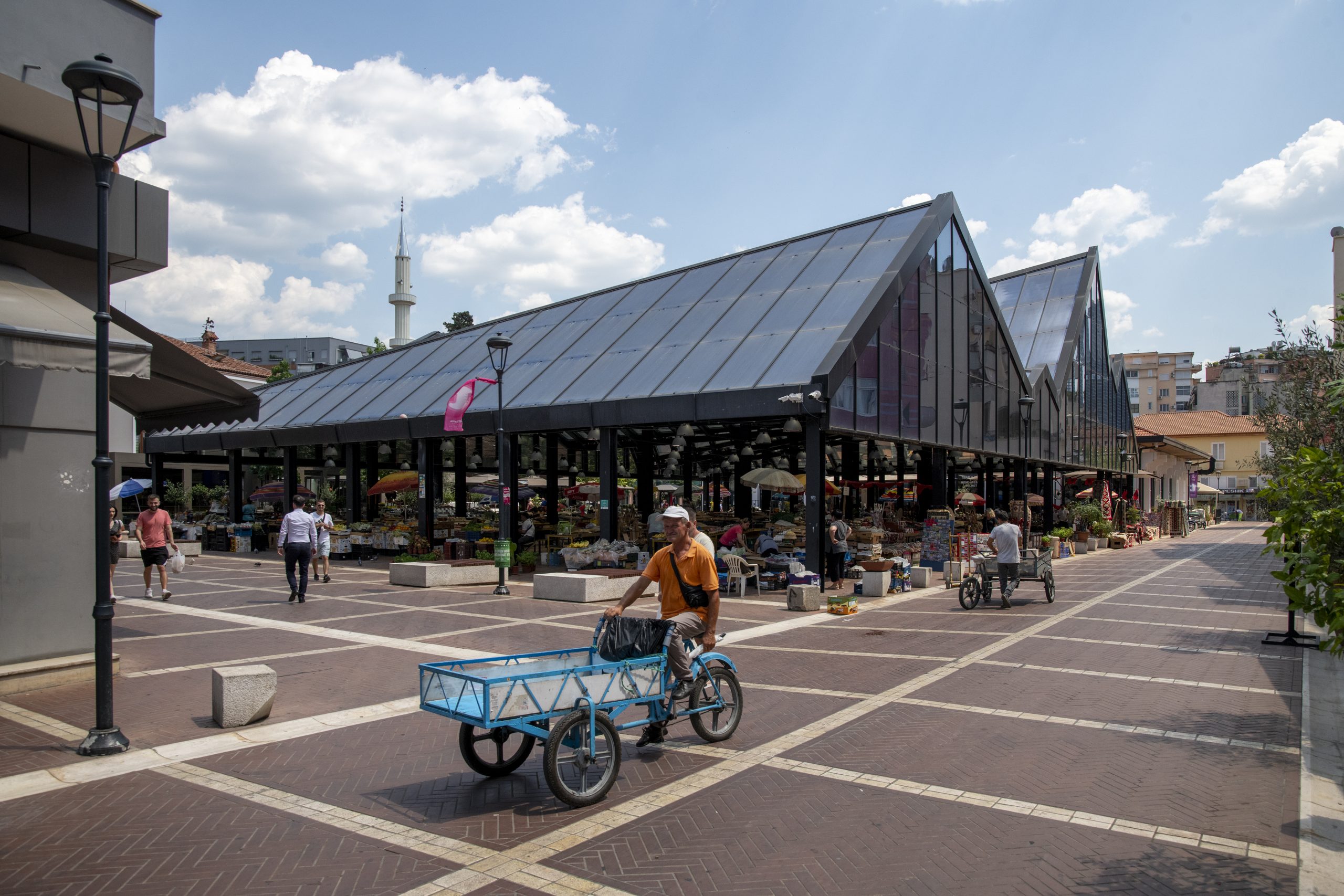
It is surprising that a mayor who belongs to a party that describes themselves as on the left measures success by the value of the property in the city. The center of his attention and policies are investors and owners, not the interests of Tirana’s residents.
As a result of these policies, according to recent reports, many investors have changed their construction investment strategy. Now they are building apartments no longer to sell, but to rent. With a trend of increasing rental properties, they find it profitable to keep ownership of apartments as a source of high investment returns.
Tirana has no rent regulations, as opposed to many cities where residents are protected against sudden rent increases, which helps mitigate the market’s tendency to push out residents that are economically vulnerable. The rental market in Tirana, apart from not being controlled in this respect, is not a free market either, as is often suggested to justify what is happening. This market is deliberately driven by local policies that serve the most powerful.
What is occurring in Tirana is a phenomenon known as gentrification. It is one of the most pressing issues with regards to the right to housing and having access to the city and its resources. In 18th century England, the landed gentry were a social class of landlords who lived only by collecting rents from their estates.
The term gentrification is attributed to the author Ruth Glass. She used the term to explain the social transformation of working-class neighborhoods in 1960s London. Residents who had historically lived there were forced out by new residents from the middle class, who, by settling in the area, increased the cost of living.
In America, gentrification also has a racial component, where racial division also corresponds to class division. Following the effects of industrialization, what is known as white-flight happened, which was the departure of white residents to the suburbs, to get away from the pollution and noise of the industrialized city. They left downtown areas which eventually became populated by the poorer classes, who were mostly black.
With de-industrialization, children born in suburbia during the baby boom — a birth boom during the period after World War II until the 1960s — and educated in good schools, showed a new attraction to the city, moving to areas that were considered degraded and investing there in housing and businesses. This return was associated with projects of urban regeneration — urban renewal — through which drastic interventions were made in the city by erasing entire poor neighborhoods known as slums. This was also perceived as a form of racial cleansing of black neighborhoods.
Populating abandoned former industrial areas with artists is another form of gentrification, as it makes the area more attractive to investors.
Abandoned areas are populated by artists — defined as the creative class by urbanism researcher Richard Florida — who agree to settle in areas where living conditions are not ideal in terms of infrastructure or comfort. At the same time, these areas give them a certain freedom to live a bohemian, unrestricted life with artistic experimentation.
This creative activity often results in small businesses that draw attention to the areas. The success of these initiatives means that the area takes on a different character which in turn causes the value of the property to increase and consequently for the gentrification process to start. Often, the artists themselves become victims of their own success as they are the first to be forced to move from these areas, unable to afford the increasing prices.
With Albania's unbridled capitalism, Tirana is facing similar forms of gentrification both in the center and in the outskirts.
In many western cities gentrification occurs in this form, but there is also resistance. Berlin is a typical example of the influence of alternative art in the city’s commodification. But it is also a place where anti-gentrification activism has increased in recent years. While this is a known phenomenon in many metropolises in Europe and North America, local administration policies driven by community activism are continuously recognizing the contribution of local communities. These movements acknowledge the cultural value these communities bring to the city and also help them negotiate their rights in order to mitigate the impact of rapid development.
Urban planners see gentrification as an opportunity to improve infrastructure and add services. However, if these changes are made without involving the existing residents in the transformation process, then people are forced to relocate due to the increased cost of living. This leads to what is known as the peripheralization of poverty and a sense of dislocation from the place where the inhabitant lives. This results in isolation, depression and high levels of stress in the displaced population.
Gentrification is seen as one of the characteristics of the neoliberal city. After the anarchic, three-decade long transition towards capitalism, neoliberalism is consolidating itself in Albania as well. As part of this unbridled Albanian capitalism, Tirana is facing similar forms of gentrification both in the center and in the outskirts, which are being encouraged by the Socialist Party’s projects and the policies of the municipality.
David Harvey, in his book “A Brief History of Neoliberalism,” highlights the contradictions between the theory and practice of the neoliberal state, which can be seen in Albania. Here, neoliberal policies are combined with authoritarianism and corruption. Ideologically, neoliberalism is based on the free market, competition and minimal state intervention.
Neoliberals seek the privatization of public property and see it as a universal right. According to Harvey, neoliberal theorists are fundamentally skeptical of democracy. Majority rule is seen as problematic for individual rights and democracy is seen as a luxury — possible only where there is a strong middle class to guarantee political stability. Therefore, neoliberals prefer leadership from the elite and from “experts.”
Neoliberal governance prefers leadership through dictate and executive orders — which in Albania is done through decisions from the Council of Ministers or Special Laws — as well as by delegating conflicts to the courts, which in Albania are not entirely functional.
Harvey argues that in practice, neoliberalism creates ideal conditions for the formation of a social class that is economically empowered by seeking not only to free itself from dependence on the state, but also by redirecting the state’s power into their favor. Thus, neoliberal conditions create a class that is uninterested in reducing the role of the state, but in utilizing the state to work in the favor of the class with economic power. Harvey argues that neoliberal capitalism’s preference is for urbanization as an outlet for capital, which always needs to be invested somewhere, overlooking serious issues of social segregation, individualism and environmental concerns.
It looks as if Tirana is making the same mistakes that other cities have made. In its quest to resemble other European capitals, it is becoming a distorted copy.
Urban anthropologist Setha Low highlights the issue of the deepening gap between economic classes in cities, which also creates problems of social segregation. Gentrification makes the economically vulnerable leave and thus makes living in the city a privilege, mostly for the middle class.
Similar to what is happening in Tirana, the rich are isolated in what Low calls fortified fragments of the city, which are otherwise known as gated communities. These are created in response to the fears that the rich have, which makes them self-isolate, increasing their security but not necessarily their happiness. This segregation is most evident in the establishment of physical barriers to separate communities, such as walls equipped with sophisticated surveillance technology.
We are seeing a shift towards Tirana becoming a segregated city, but this does not concern policy makers. Tirana is on the path to make the same mistakes that other cities before it have made. In its quest to resemble other European capitals, it is becoming a distorted copy.
Bulldozers at your doorstep
On January 19, 2022, I happened to be in Tirana, when the city was being torn apart in another area, near the river. The neighborhood, known as 5 Maji, takes its name from the main street that leads to it, which starts from the intersection with the Medresea and continues to the river.
Along the street, you pass stretches with different urban characteristics. From the Medresea down to the “Unaza” roundabout is a street mainly dedicated to used or cheap goods. At Unaza is the Medresea Market where the commerce gets noisy and dynamic. In front there are low brick buildings with small shops on the ground floors.
Continuing along 5 Maji Street, at the end of the market is an area under construction, with multi-story buildings with shops on the first floor and offices on the second. This is a model repeated throughout the city, without consideration for context or the needs of the community. Further down the road, you encounter some former warehouses and then typical two or three story houses built by those who moved to Tirana during the demographic shifts that followed the fall of the communist regime.
I joined the activists of a newly formed group called “The Right to the City“ whose activity interweaves the disciplines of social, political, economic and urban sciences. I had been in the area with them before, in one of the daily meetings that the residents of the area held to discuss their situation.
This day was different. Trucks loaded with sofas, wardrobes, mattresses, refrigerators and televisions were driving along the streets of 5 Maji, carrying also some disheartened residents. As the trucks drove down the main road, bulldozers were crushing their homes. The policemen were fighting with a woman in traditional Mirdita clothing. She was insistently searching for clothes that were left in the house, traditional garments that she had set aside to be dressed in when she dies.
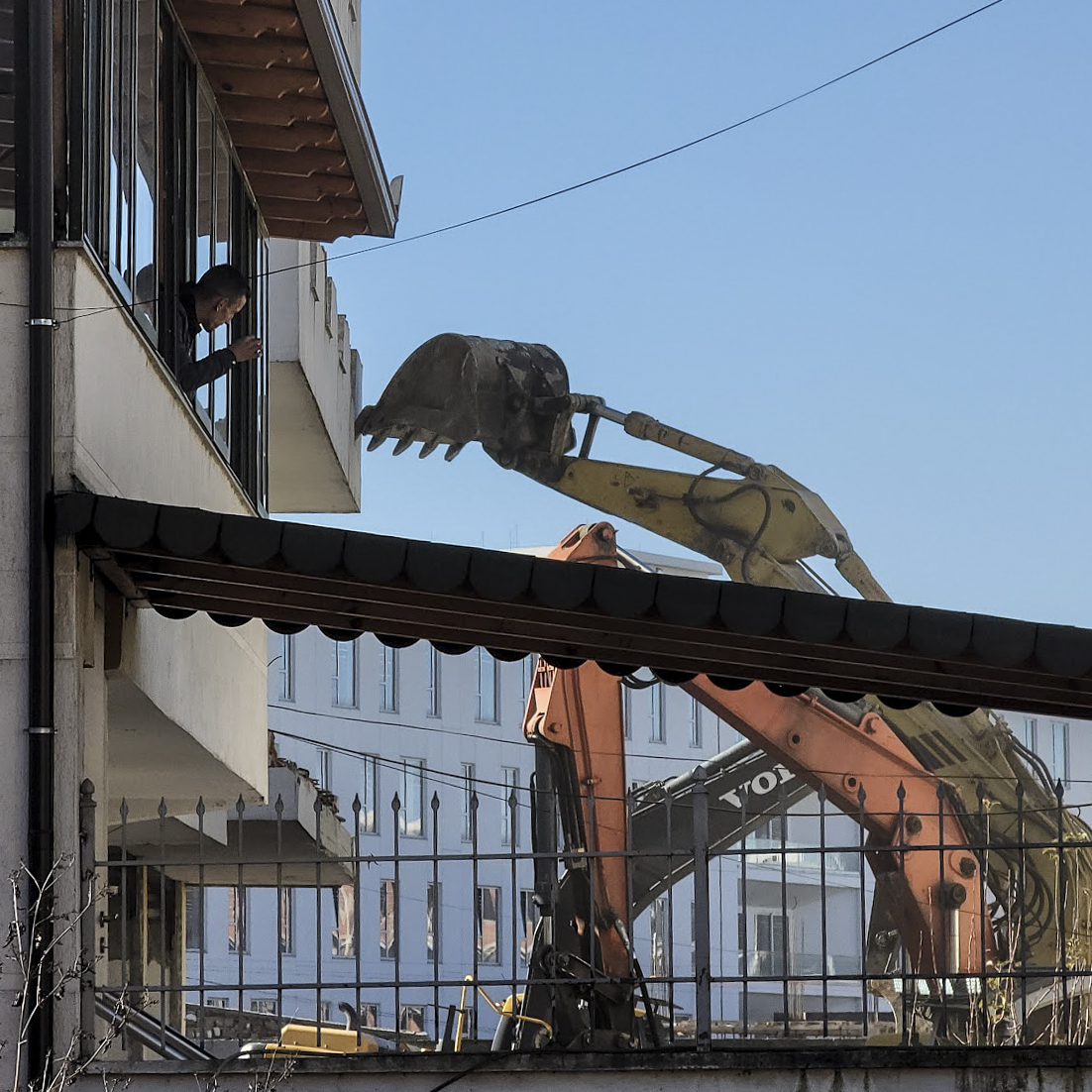
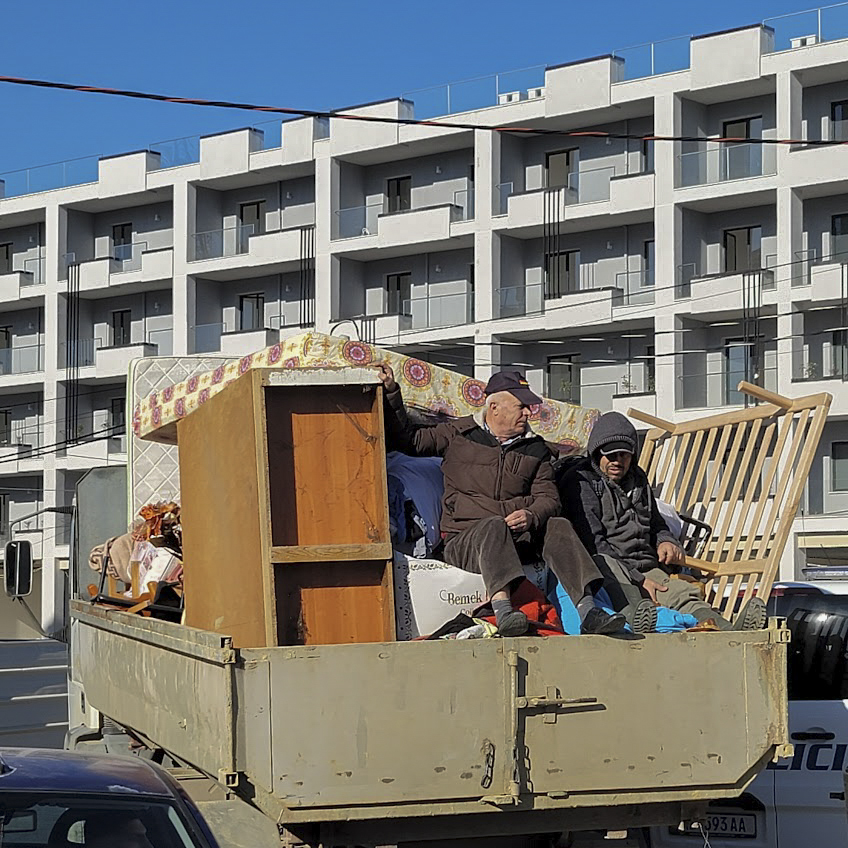
She was “Mother Liza,” and from that moment on she became known throughout Albania. The contents of her house had been forcibly taken outside, and she was struggling to breathe, cursing those who did this atrocity in front of her. She remembered her husband, who, before he died, ensured they had the best conditions, were at peace and minding their own business, in the house that they had built. It was built with hard work and sweat, with the contributions of the entire family: children, women, men and even neighbors.
Mother Liza was told that this is being done in the name of progress, but she could not believe that this progress was a good thing, when it consisted of so much violence.
Residents were showing messages and threats they had received, a demonstration of the tensions in the run up to this day. They received official letters about relocation were to sign, but the letters did not include information about when and where they would get their apartment, or how big it would be, on which floor, or which side would be facing the sun. This means that they could not imagine the new life that was being imposed on them, which could have provided the residents with a little comfort.
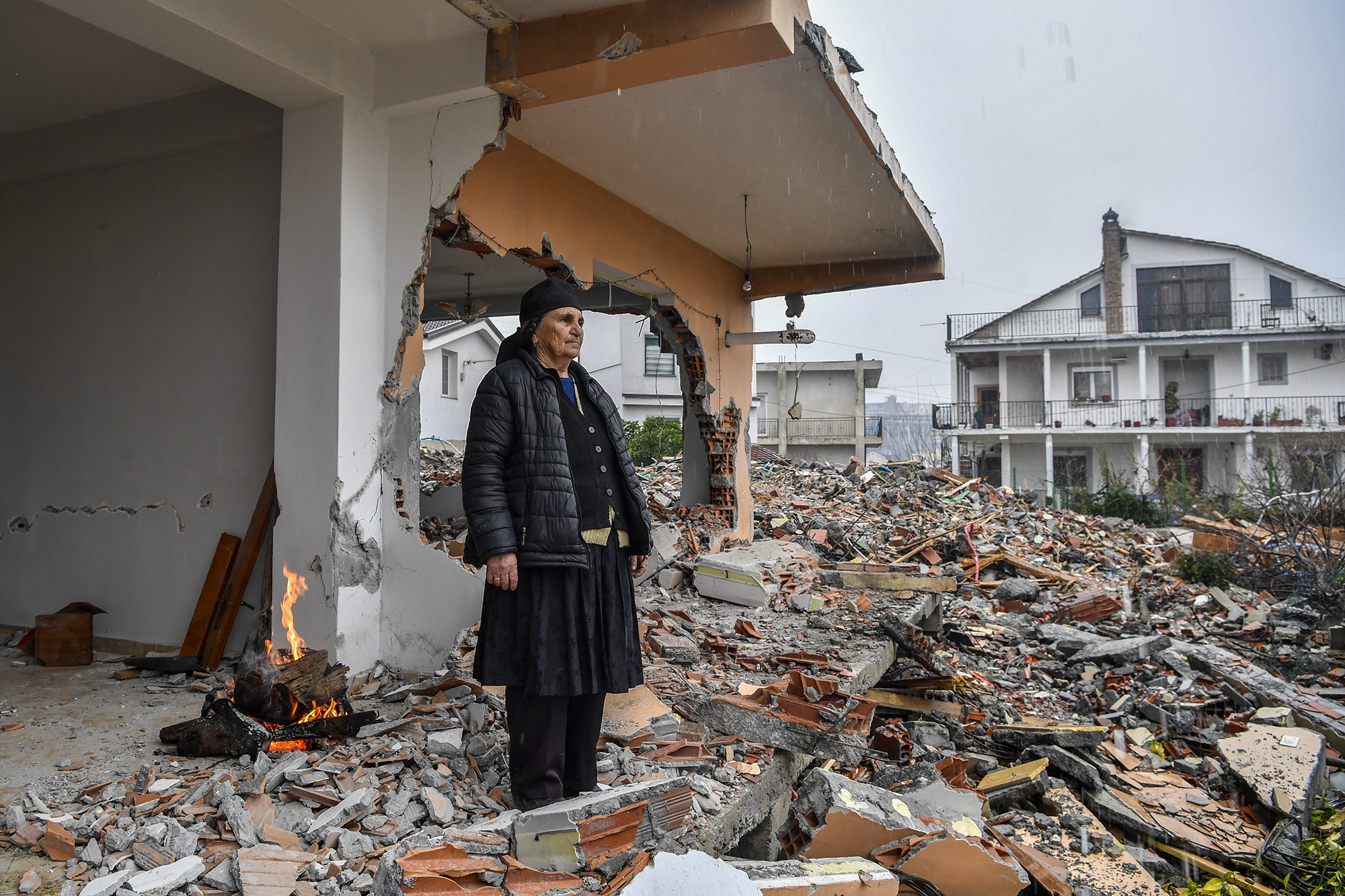
Mother Liza was told that this is being done in the name of progress, but she could not believe that this progress was a good thing, when it came with so much violence.
Mother Liza did not know where her neighbors’ new house would be, with whom she had shared joys and sorrows for years. She hadn’t signed anything, and yet today dozens of policemen entered her house and removed her by grabbing her by her arms and carrying her out. The bulldozer had torn out the wall overlooking the kitchen on the third floor. They had only recently built the kitchen after years of cooking with a makeshift oven. When the bulldozer hit the concrete steps, the whole earth trembled.
I was witnessing this scene near a journalist, a friend of mine, who I met through the Feminist Collective. Near us was Mara, a woman who stood silently watching the whole scene, looking desperate and enraged. “They have marked our house too,” she told me. “They will destroy our house as well. All of our life savings have been invested in that house, we raised our children there. Today we are staying in a room downstairs, we have removed all the windows and doors ourselves to save whatever we can.” We asked if she wanted to speak in front of the microphone, she said that she wanted to speak out about the effort of building their home but her husband didn’t want her talking to journalists. (Mara is a pseudonym.)
I understand the constant pressure to silence her as a woman, to suffocate a natural human reaction, that nervous outburst, to raise her voice and to release her anger. This is traditionally perceived as a threat to masculinity, what Freudian psychoanalysis categorizes as female hysteria is a way to suppress female experience. Culturally designed from birth as a domestic creature, whose body and thoughts are censored, and any departure outside the frame of a gentle woman’s behavior is seen as an anomaly.
When I asked Mara what home meant to her, she replied that it was everything. She remembered her grandmother’s words when she was leaving her house as a bride, “The house belongs to the woman, it shows how good and hardworking you are. A man has as many troubles as there are holes in the walls of a home. It’s not easy, you have to keep quiet and make room for yourself, my daughter!”
She had washed and scrubbed that floor so hard. She told me how the floral and rhombus motifs of the carpets and rugs are still fresh in her mind, that weighed so much, when she shook them with all her strength to hang them to air on the veranda. She never got tired of asking the children to take off their shoes when they got inside the house hastily. “Girls are different, they take off their shoes, because they are girls. The boys are disorganized, there’s nothing you can do about it, they are boys,” the neighbor from the house opposite would say to her.
Papers, ownership, legalization, all of that — men’s topics. She never dealt with that, because she had no time. She had to make sure that the floor was washed, the carpets were shaken, the blankets were laid out, and the food was on the table. Everyone was happy when they finally received the certificate that legalized their ownership, after almost 20 years of waiting, on the eve of the last elections. They had never understood how some of the neighbors had received it faster and some never did, until the day that the bulldozers came to their doors.
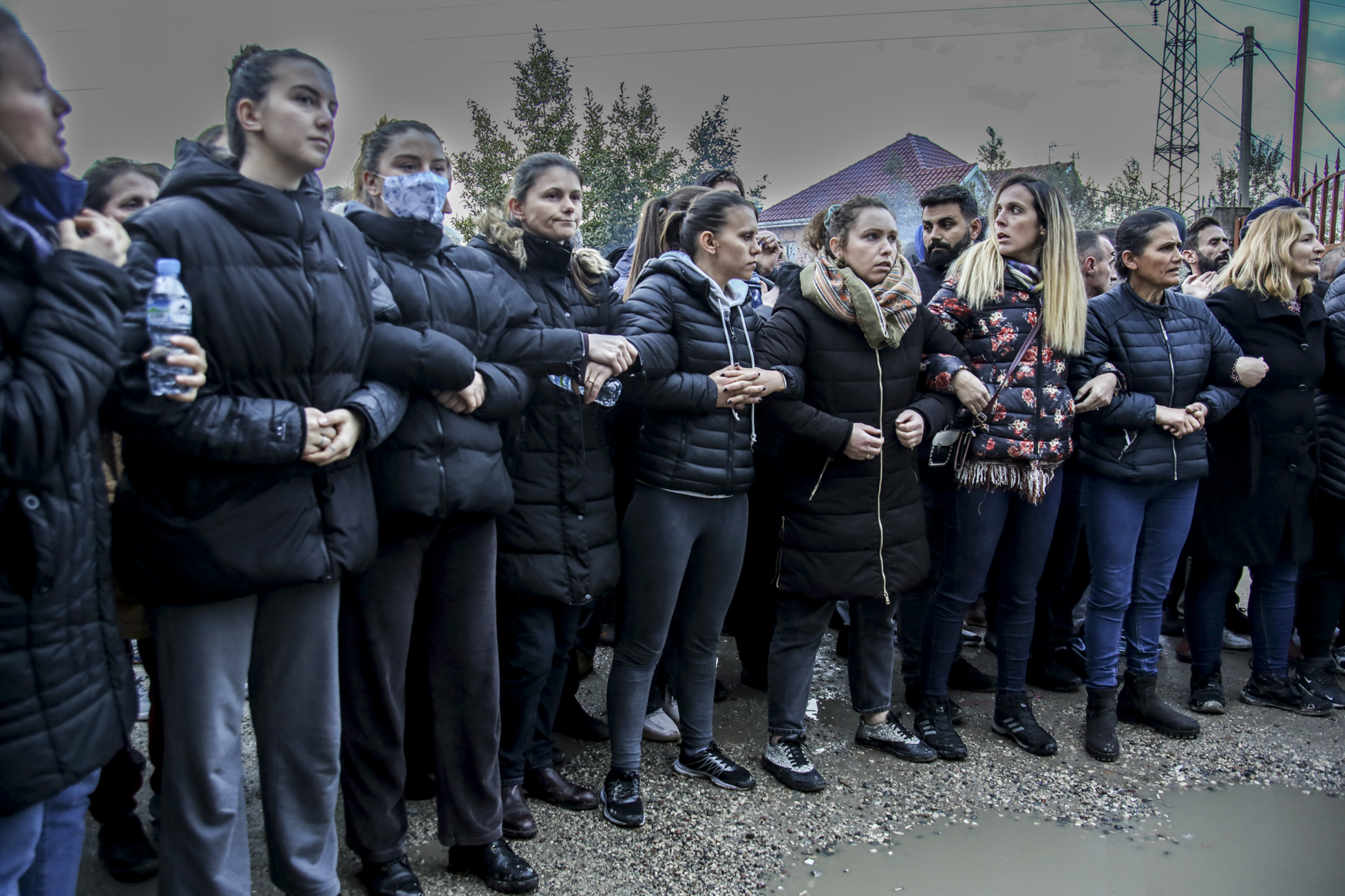
I was amazed to see her, there at the front, on the day when her house was demolished, on February 22, standing side by side with her friends, full of courage and determined to face the police. “The house belongs to the woman,” her grandmother had told her, “to keep it clean.” But that day she, along with her friends and sisters, was there to protect it from the bulldozers.
Who does progress belong to?
Tirana 2030’s smaller follow-up plans, known as Mandatory Local Plans, disrupt the urban reality of the city by removing existing communities. The implementation of these plans in 5 Maji and in Kombinat is being done quickly and violently, taking advantage of the emergency housing of residents left homeless by the earthquake. With the Churchillian motto “never let a good crisis go to waste,” the leadership is using the earthquake reconstruction as an opportunity to bypass the legal procedures that would normally be called for, including public discussion.
The development of these plans has again been entrusted to two Italian architects close to Rama. Stefano Boeri, compiler of the Tirana 2030 general plan, has also designed the masterplan for the 5 Maji area. He renamed this area from Bregu i Lumit, as it is widely known (meaning riverside in Albanian) to the English “Tirana Riverside.”
As a continuation of his greenwashing rhetoric, Boeri adds another propaganda element to this master plan and names 5 Maji as the first anti-covid neighborhood in Tirana. Advertisements for the plan show mixed-use residential blocks with green facades and flying drones. The drones, apparently, herald the hi-tech future of the area. The claim is that the drones will make deliveries to the terraces of the apartments and reduce the need for physical contact during a pandemic. The distraction of the drone claims, which are unrealistic, creates a glamorous impression of progress through architecture.
In the name of reconstruction after the earthquake, the Italian studio Archea Associati headed by architect Marco Casamonti has renamed the area around the former Stalin Textile Factory from Kombinat to “Kombin-Art.” From its first foundations, the area has been composed of two areas with separate functions, a residential neighborhood and an area with services and industry. The new name “Kombin-Art” was approved during the pandemic and presented to the public online as a fait accompli.
The master plan foresees the demolition and reconstruction of almost the entire neighborhood. The demolitions have begun but a group of residents has organized and is taking complaints to court. They’ve already won some cases.
Meanwhile, demolitions are taking place in the former industrial facilities, where hundreds of families, mainly from northern Albania, have been living for almost three decades, squatting in the abandoned buildings. All these years they have been considered as merely occupiers. Residents tell how the giant structures first served as basic shelters, but it took a long time for them to become habitable.
They have slowly improved their living conditions by investing as they could, little by little. The residents worked together to solve common issues with the building’s infrastructure, ventilation, windows and dividing yards. In this way, the process of building and transforming their homes has served as an experience that creates and consolidates communities.
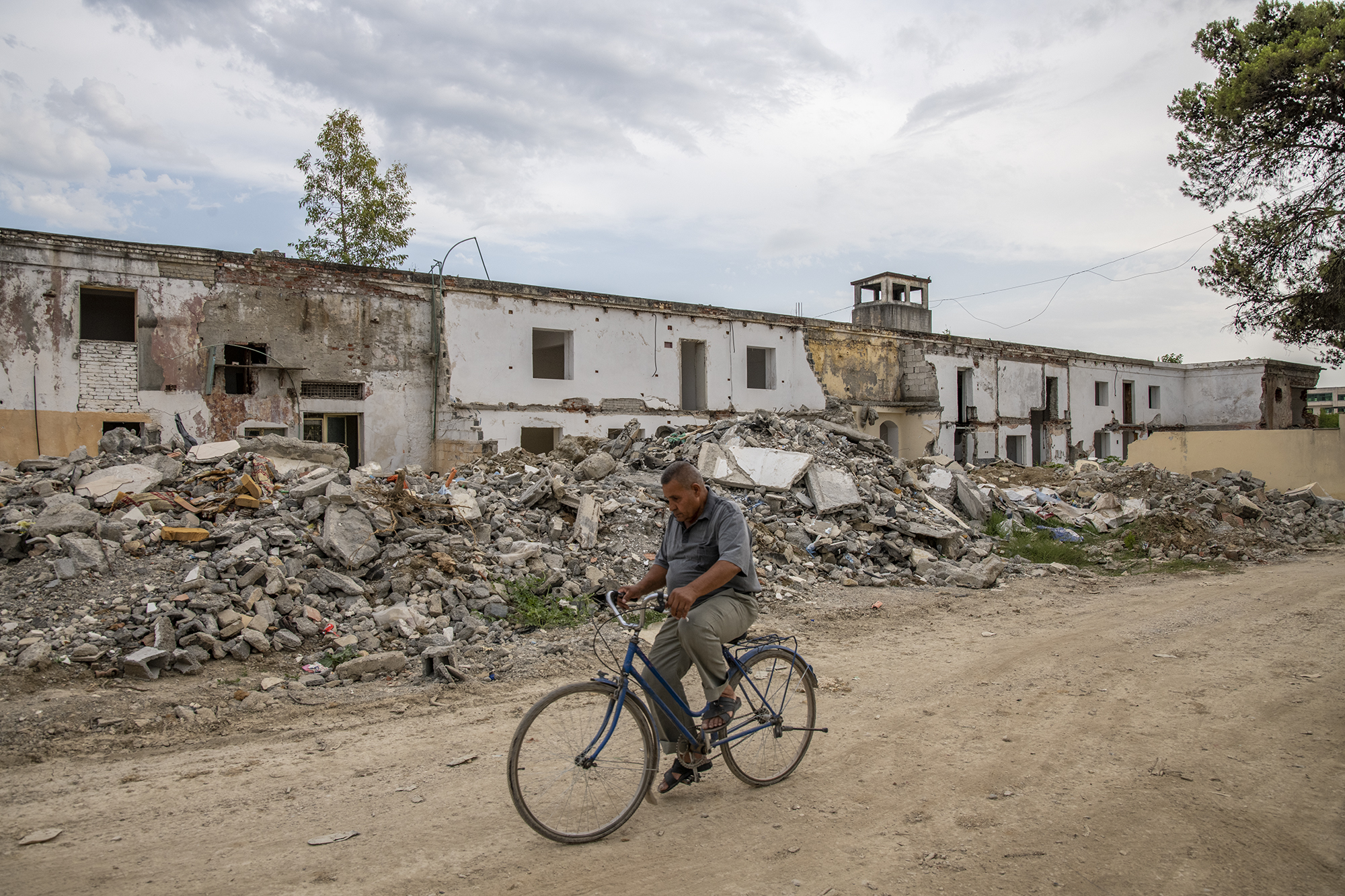

According to the new plan from the architectural studio Archea Associati, all of these buildings and the communities that have formed within will be erased to make way for new buildings. The demolitions are being done in stages. The residents live with the uncertainty of not knowing when their time will come. Some residents have even hired bulldozers to demolish their lot themselves in order to save what they can from their home, including building materials, especially iron. Here, there is no resistance against the demolitions, but the residents hope that the municipality will fulfill their promises and give them new apartments.
These areas around the northern periphery of Tirana, including the Kamëz municipality, were built by the people in an informal manner. This use of the term informal was originally defined by the International Labor Organization, a United Nations agency that advocates for justice in the labor sector, and then borrowed into the field of architecture and urban planning. Though it is a term that is being challenged in these disciplines, it is still widely used in the political and academic discourse in Albania.
Informal is a term defined by denial. It does not emphasize what is, but what is not. The definition of informal is based on the belief that such self-built places are entirely outside the codes of the academic and professional discipline of architecture.
At the same time, the institutional code has kept these areas officially unrecognized. As a result, the people who created and populated them are defined as newcomers, as others. The concept of “the other” refers either to interpersonal relationships with those different from oneself, but also a kind of cultural hegemony, which excludes specific social groups from socio-economic institutions, placing them in a lower position. Political power considers these people as semi-legitimate.
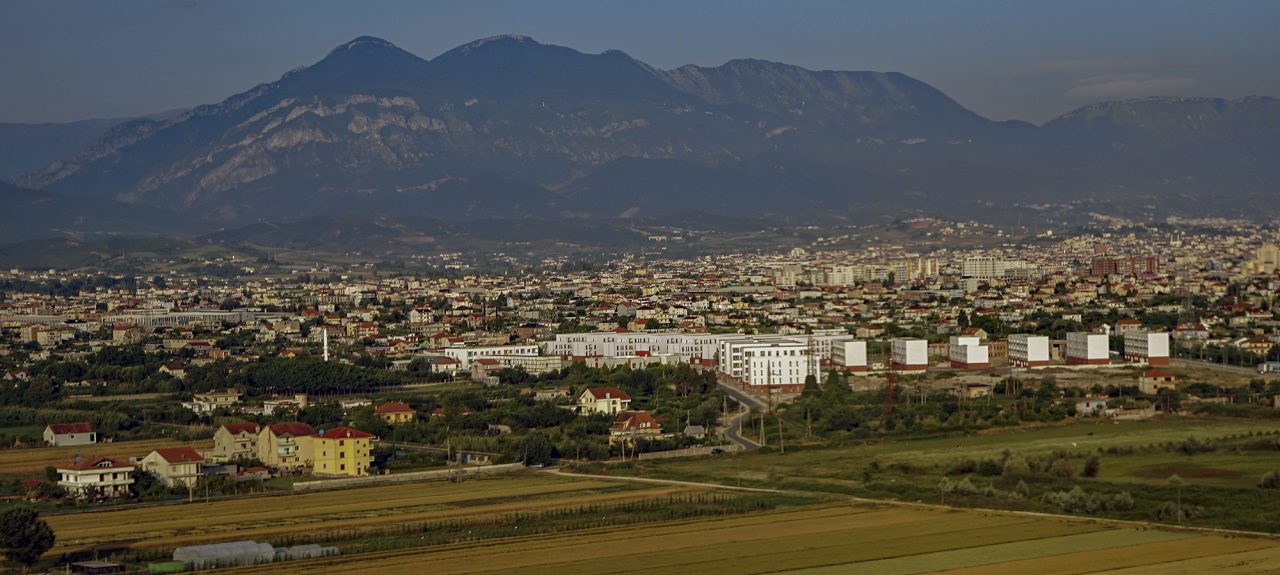
The city created by the residents
Kamëz is one of the largest municipalities in Albania. With the mass migration of people to Albania’s western lowlands during and after the 1990s, Kamëz was transformed from an agrarian and mining area into a residential area. The construction of Kamëz as a city took place from the bottom up, by the inhabitants themselves, relying on family and community resources. This was initially due to the absence of the state.
Today, Kamëz is a city with a variety of ways of life. New residents have brought new practices with them and combined them with others during their coexistence. Experiences with emigration have also had a heavy impact, as in the rest of Albania. In Kamëz this connection to emigrants can also be seen in the interwoven construction culture.
The language used in public to refer to the inhabitants of these areas corresponds to a general social stigma for the inhabitants originating from the northern mountainous area, labeled with the derogatory term malokë (mountain people). The mayor used the term “shpellarë” (cavers) for the residents of the Astir area and “squatters” or “people living in septic tanks” to refer to the residents of 5 Maji.
With this language, Veliaj shows contempt for a way of life that he judges foreign. There is contempt for all the material endeavors of these people, their struggle to build a life without the help of the state and to rely instead on community and kinship.
This community sphere, standing as a third sphere beyond the public-private dichotomy, has been essential for the formation of these areas. It is not immune to phenomena that affect the entirety of Albanian society, such as emigration and individualism, which destroy it every day. Derogatory language and the violent intervention of power is fatal to the relations of these communities. In addition, this behavior and this way of exercising political power increases social division and polarization.
This is a reproduction of the stigma that seemed to have lessened in recent years, but which has returned to public discussions for populist reasons. This discourse aims to arouse support from a particular social category, namely residents of Tirana who came to the city earlier, during the communist period, who consequently had easier access to the administration and the capital’s resources.
This polarization induced from above was reflected in how Mother Liza was perceived by the public, some people supported and stood in solidarity with her, and some despised her. The leaders of Tirana and Albania today seek to align with the people who symbolize progress, who, in the name of being European, deny popular culture. It seems as if Tirana is being built precisely for this social category, expelling those who are seen as primitive and an obstacle to progress.
If the apartment building model becomes the only form of development for Tirana, we will have lost the opportunity for a diverse city.
The areas that residents themselves built are so widespread that they can not be ignored. The formation of these neighborhoods were outside the logic of the state and the market. The intervention of the state, using the discipline of architecture, comes into conflict with the autonomous character of these areas. The discipline of architecture has been largely Eurocentric and is only in the first stages of questioning its dominant methods, despite the fact that many writers inside and outside the discipline have raised concerns about its deterministic character.
It is essential for architecture to collaborate with other disciplines such as anthropology, sociology and urban geography to understand the culture of the country where it is intervening. If, as we are seeing, the apartment building model is the only form of development for Tirana, we will have lost the opportunity for a diverse city.
American sociologist Sharon Zukin points out the tendency of the contemporary school of urban design and architecture to design mainly for the upper middle class, which serves as a driver of gentrification and which is able to pay for housing in the market. The criticism she makes of this phenomenon is that architecture focuses on a specific way of life, producing a kind of universal and homogenizing design that sterilizes other ways of using and inhabiting space.
In this sense, a governing party that claims to be on the left should be more empathetic to the popular and communal character of the areas that communities have created for themselves and appreciate these spaces for what they are instead of erasing them violently or reinforcing the stigma that exists against them. The state after the 1990s, at first anarchic and then corrupt, is today an enemy of many citizens.
Even in her most difficult days when she was forced to leave her home, courage and pride could be seen in the face of Mother Liza. The women of 5 Maji showed resistance and courage facing the police and bulldozers. Thousands of hearts were touched and united in resistance for the defense of the theater. This is the Tirana that resists violence and the culture of domination. Progress can not come from such things.
Progress comes first from the policy of accepting and understanding others, from building a culture of communication, empathy and a spirit of negotiation.
But they are in a hurry. They have no time to waste.
Feature Image: Atdhe Mulla / K2.0.
![]()
![]()
This article has been produced with the financial support of the “Balkan Trust for Democracy,” a project of the German Marshall Fund of the United States and the Norwegian Ministry of Foreign Affairs. Opinions expressed in this article do not necessarily represent those of the Norwegian Ministry of Foreign Affairs, the Balkan Trust for Democracy, the German Marshall Fund of the United States, or its partners.
Why do I see this disclaimer?
